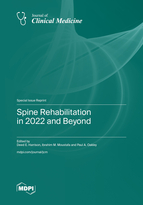Spine Rehabilitation in 2022 and Beyond
A special issue of Journal of Clinical Medicine (ISSN 2077-0383). This special issue belongs to the section "Clinical Rehabilitation".
Deadline for manuscript submissions: closed (30 June 2023) | Viewed by 88331
Special Issue Editors
Interests: spine rehabilitation
Special Issues, Collections and Topics in MDPI journals
2. Basic Science Department, Faculty of Physical Therapy, Cairo University, Giza, Egypt
Interests: spine rehabilitation; spine biomechanics; clinical outcomes; spine deformity; neurophysiology; physical therapeutics
Special Issue Information
Dear Colleagues,
Spinal disorders and disabilities are among the leading causes for work loss, suffering, and health care expenditures throughout the industrialized world. The psycho-social and economic impact of spine disorders demands continued research into the most effective types of preventative and interventional treatment strategies. In the past two decades, the role that sagittal plane alignment of the spine and posture has on human performance, health, pain, disability, and disease has been a primary research focus among spine surgical and rehabilitation specialists throughout the scientific literature. It has been extensively demonstrated that sagittal plane alignment of the cervical and lumbar spines impacts human health and well-being. Limits of normality for a variety of sagittal spine alignment parameters have been documented providing chiropractors, physical therapists, surgeons, and other spine specialists with standardized goals to compare patients to in both pre and post treatment decision making strategies.
Recent randomized controlled trials using spine extension traction methods in conjunction with various conventional physiotherapeutic methods have demonstrated that patients with cervical, thoracic, and lumbo-pelvic sagittal plane abnormality-induced symptoms achieve greater long-term health outcomes versus patients who only receive conventional treatments that do not improve spinal alignment. In fact, although all patient groups showed initial symptomatic relief, the groups not receiving spine extension traction methods to improve sagittal plane alignment do not typically show structural improvements in their spine. Furthermore, the conventional treatment (non-spine corrective) only groups had regression of their symptoms back to pre-study values as early as 3 months following the cessation of treatment. In contrast, patient groups receiving the spine extension traction to improve physiologic lordosis, reduce hyper-kyphosis, and reduce anterior head translation posture maintained their structural realignments, maintained symptomatic improvements, and also had a number of positive health measures continue to improve after the cessation of treatments for up to 2 years.
Today there are reliable and predictable means through application of structural rehabilitation of the spine and posture as part of comprehensive rehabilitation programs to restore the natural curvatures of the spine. High-quality evidence points to spine corrective methods offering superior long-term outcomes for treating patients with various craniocervical and lumbosacral disorders (not limited to scoliosis). The economic impact, health benefits, and generalized awareness of these newer sagittal spine rehabilitation treatments demands continued attention from clinicians and researchers alike and this is the purpose of this collection of publications.
All papers submitted to this Special Issue are reviewed by independent referees, and the final decisions are made by a JCM Editorial Board Member who does not have any conflict of interest with the submission.
Dr. Deed E. Harrison
Prof. Dr. Ibrahim M. Moustafa
Dr. Paul A. Oakley
Guest Editors
Manuscript Submission Information
Manuscripts should be submitted online at www.mdpi.com by registering and logging in to this website. Once you are registered, click here to go to the submission form. Manuscripts can be submitted until the deadline. All submissions that pass pre-check are peer-reviewed. Accepted papers will be published continuously in the journal (as soon as accepted) and will be listed together on the special issue website. Research articles, review articles as well as short communications are invited. For planned papers, a title and short abstract (about 100 words) can be sent to the Editorial Office for announcement on this website.
Submitted manuscripts should not have been published previously, nor be under consideration for publication elsewhere (except conference proceedings papers). All manuscripts are thoroughly refereed through a single-blind peer-review process. A guide for authors and other relevant information for submission of manuscripts is available on the Instructions for Authors page. Journal of Clinical Medicine is an international peer-reviewed open access semimonthly journal published by MDPI.
Please visit the Instructions for Authors page before submitting a manuscript. The Article Processing Charge (APC) for publication in this open access journal is 2600 CHF (Swiss Francs). Submitted papers should be well formatted and use good English. Authors may use MDPI's English editing service prior to publication or during author revisions.
Keywords
- spine rehabilitation
- spinal deformity
- clinical trial
- review
- spine biomechanics
- clinical outcomes
- chiropractic
- physiotherapy









